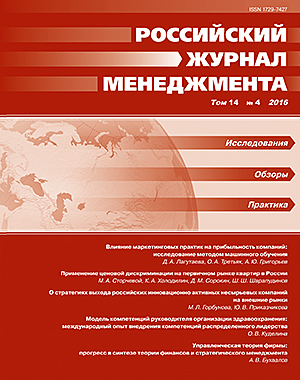On Contemporary Internationalization Strategies of Russian Innovative Non-Commodity Companies
DOI:
https://doi.org/10.21638/11701/spbu18.2016.403Abstract
The search for the new ways of international expansion of manufacturing businesses suggests a study of the experience of internationalization of Russian companies that have arisen in the post-Soviet period and are often associated with the so-called “new” economy. Using secondary data, the authors conducted a comparative analysis of the key aspects of the international strategy of the Russian “gazelle” companies in order to identify and generalize best practices of developing
and maintaining the international competitiveness. The results demonstrates that the success of the enterprise in question on foreign markets is closely connected to the implementation of innovative strategies. Their strategic decisions concerning the complexity of the international business organization, the degree of exposure of overseas expansion, the predominantly ethnocentric orientation, the product range offered on foreign markets commonly correspond to the
initial stage of their internationalization. Despite this, the Russian innovation-active mediumsized companies seek to enter a significant number of foreign markets.
Keywords:
gazelle firms, exporting, competitive advantages, innovations, internationalization strategies
Downloads
References
Translation of references in Russian into English
Downloads
Published
How to Cite
Issue
Section
License
Articles of the Russian Management Journal are open access distributed under the terms of the License Agreement with Saint Petersburg State University, which permits to the authors unrestricted distribution and self-archiving free of charge.





